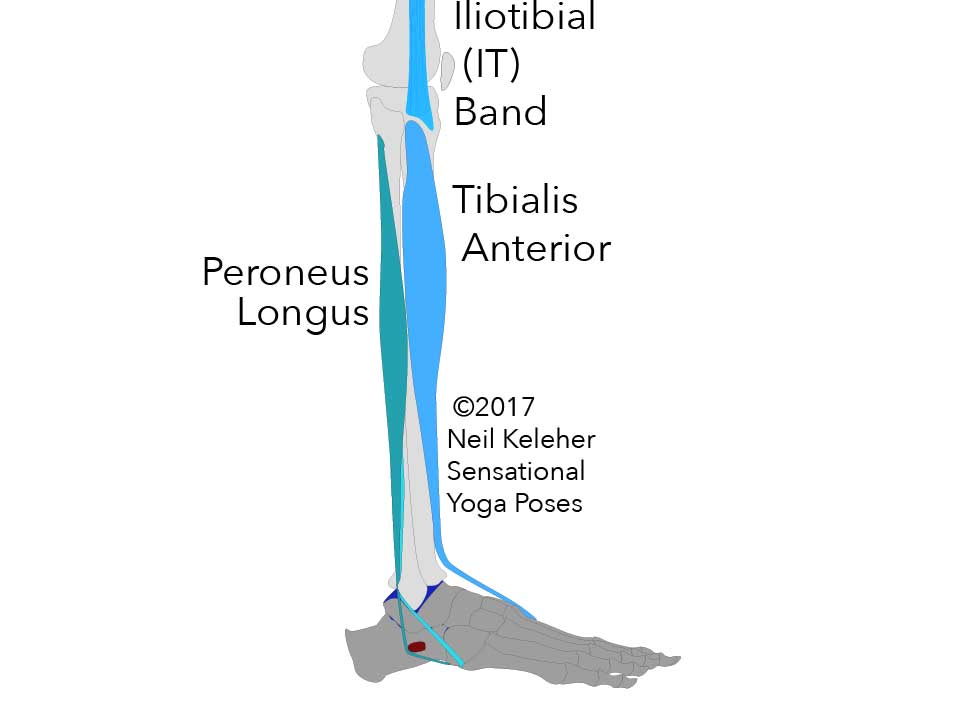Peroneus Longus
Helping to anchor the fibula and shape the foot
Peroneus longus attaches to the outside of the fibula (the outermost and smallest of the two lower leg bones).
Its lower tendon bends around the outside edge of the foot and passes under the sole of the foot like a sling.
When active, it can create visually noticeable "race-lines" down the outside of the shin. It also creates a strong sensation down the length of the side of the shin.
If you press down alongside the outside edge of the foot and then activate peroneus longus, you may notice that it creates a downwards pulling sensation on the fibula.
Path of The Lower Tendon of the Peroneus Longus
Near the bottom of the fibula, the tendon of the peroneus longus passes backwards behind the Lateral Malleolus before moving downwards along the side of the heel bone.
The Lateral Malleolus is the knob of bone that sticks out of the outer side of the ankle. It is actually the bottom part of the fibula.
The Trochlear Process or Peroneal Tubercle
Supporting the bottom of the tibia is the talus or "ankle bone." Directly below the talus is the calcaneus. The calcaneus could be thought of as the "heel bone".
On the outside or lateral surface of the calcaneus is a squarish projection called the Trochlear Process (also known as the Peroneal Turbercle).
You may be able to feel the protrusion of the peroneal tubercle just below and in front of your lateral malleolus.
Tilting the Heel Inwards
Passing down the side of the calcaneus, the tendon of the peroneus longus passes behind the trochlear process before reaching forwards to about the midpoint of the outer edge of the foot.

In this image the, trochelar process is highlighted with a reddish color.
Assuming a standing position with the feet bearing weight, an activated peroneus longus can create a forwards and upwards pull on the outside edge of the heel bone via the trochlear process.
The peroneus longus can thus cause the heel to tilt inwards (because of the upwards and forwards pull it creates on the trochlear process).
Stabilizing the Heel
If this inward tilting force is resisted by the action of the tibialis posterior, then the heel can be stabilized so that it resists tilting outwards or inwards.
The Cuboid
Attaching to the front face of the calcaneus is a bone called the cuboid. The cuboid could be thought of as the base of the outer two (little) toes.
The peroneus longus folds around the cuboid bone before passing forwards and inwards along the bottom of the foot via a canal along the underside of the cuboid bone.
Assuming that the heel bone is stabilized by the opposing actions of peroneus longus and Tibialis posterior then the tibialis posterior may furthermore create an upwards pull on the cuboid.
It can thus help to support the arch of the outer foot (though it can be difficult to see the "lift" of this arch.
The Cuneiforms
Attaching to the front of the talus is a bone called the navicular. Attaching to the front of the navicular are three side-by-side bones, called cuneiforms. The outermost cuneiform and navicular both sit next to the cuboid bone.
The cuneiforms could be thought of as the start of each of three (bigger) inner toes.
After passing through the channel at the bottom of the cuboid, , the peroneus longus then passes along the underside of the outermost two cuneiforms before attaching to the underside of the innermost cuneiform and to the rearmost part of the base of the innermost metatarsal.
The metatarsals could be thought of as the part of the toes that lie within the foot.
When active, the peroneus longus can help to anchor the base of the innermost metatarsal.
The base of the metatarsal is the end of the bone closest to the ankle.
Anchoring the Lower Leg
Assuming an activated tibialis posterior while standing, an activated peroneus longus helps to stabilize the heel laterally, preventing heel tilt. Because the shin now resists rotation, the cuboid tends to resist the upwards pull of the peroneus longus tendon.
As a result, the peroneus longus creates a downwards pull on the fibula. Since the biceps femoris attaches to the upper end of the fibula, this action helps to create a stabilized anchor point for that muscle.
An activated Tibialis Anterior helps to complete stabilization of the lower leg while standing.
Anchoring the Gluteal Portion of the IT Band
According to Thomas Meyers' anatomy trains the peroneus longus has connective tissue fibers that are continuous with the rear portion of the IT Band. This is the portion of the IT band that is tensioned by the superficial fibers of the gluteus maximus.
If peroneous longus is active and stabilized at the lower end via opposition from the peroneus longus, it can help to act as an anchor for the rear portion of the IT band. This may help in alleviating IT Band Knee Pain.
Lifting the Outer Edges of the Feet
If the tibialis posterior is relatively relaxed, then activation of the peroneus longus can lift the outer edge of the foot. Sitting upright with legs straight ahead, this same activation pulls the outer edges of the feet rearwards, towards the hips.
In a pose like pigeon pose with the front hip on the floor and the front shin parallel to the front, then activation of this muscle can pull back on the outer edge of the foot and also help you to press the outer edge of the foot into the floor.
In a pose like bound angle pose, with feet together and knees bent, even if the soles of the feet are turned upwards, the peroneus longus can activate against tibialis posterior to help stiffen the feet so that you can press the edges of the feet firmly into the floor.
Published: 2020 08 05



